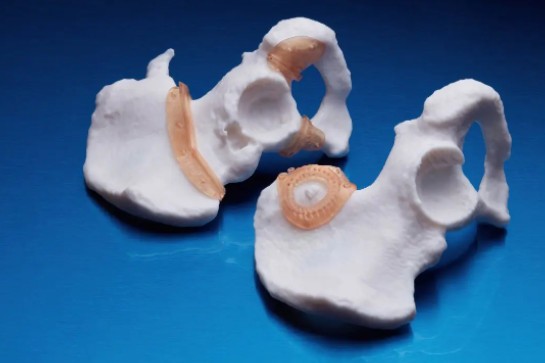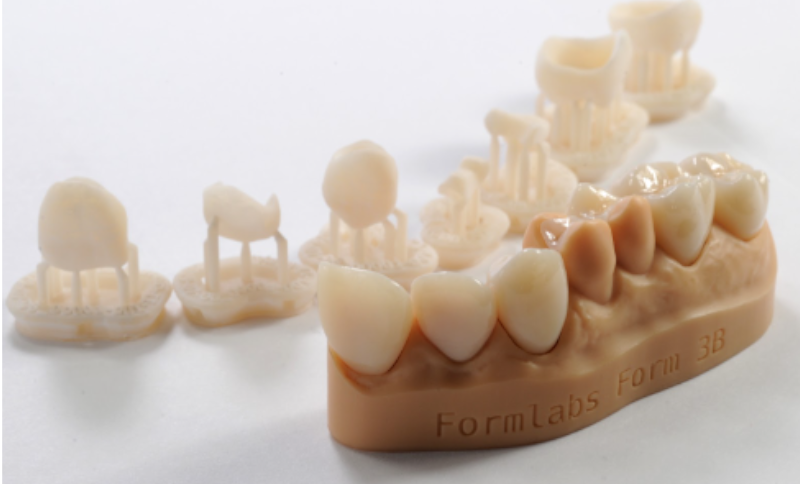
Biocompatibility is the ability of certain materials to act with an appropriate response to the biological environment in which it is used. The term biocompatibility is mainly applied to medical materials that are intended for direct, brief or prolonged contact with internal tissues and fluids of the human body.
In 3D printing for the medical and dental sector, materials with specific properties such as biocompatibility are playing an increasingly important role, which is indispensable for the manufacture of parts for the medical environment.
When talking about biocompatibility in the field of 3D printing, it is important to understand what biocompatible materials or biomaterials are, and to bear in mind that optimised or certified equipment must be used to process these materials.
Biocompatible materials or biomaterials
Biocompatible materials, also called Biomaterials, are those that have been developed to interact with biological systems for a medical purpose.
It is important to differentiate biomaterials from biological materials, which are those produced by a biological system, such as bone.
Biocompatibility classes
Devices or materials intended for medical use are referred to as medical devices. All medical devices must be classified according to their associated risk, which is determined by the mode of use, type of tissue contact and exposure time. This classification is based on classes, where a higher class implies a higher risk. It is important to distinguish whether the classification is according to the US FDA regulations or according to the European Medicines Agency regulations. Although both use the class system, their grades and meanings are slightly different. The FDA system is based on 5 classes with Class I being those products with the lowest associated risk and Class V being those with the highest risk. In the following table you can find the application classes for each case:
| Contact with the body | Duration of contact | |||
|
Permanent |
Prolonged (24-30 days) |
Limited (<24 hours) |
||
| Surface devices | Skin | Class I | Class I | Class I |
| Membranes and mucosa | Class V | Class III | Class I | |
| Gaps or compressed surfaces | Class VI | Class V | Class III | |
| External communication devices | Blood route, indirect | Class VI | Class V | Class IV |
| Dentine communication | Class VI | Class VI | Class IV | |
| Circulating blood | Class VI | Class VI | Class IV | |
| Implant devices | Tissue or bone | Class VI | Class VI | Class VI |
| Blood | Class VI | Class VI | Class VI | |
Table 1: Biocompatibility classes according to the FDA. Source: Filament2print.
The European classification is based on only three levels: Class I, Class II and Class II.
- Class I: Includes all those products that only come into contact with the skin or penetrate briefly through the nose or mouth. They are considered low-risk products. Within class I medical devices there are two subgroups:
- Class I sterile: For example gloves, gauze, isopes or syringes (without needle).
- Class I measuring devices: e.g. analogue thermometers.
- Class II: These are intermediate risk products. They are further classified into two subgroups:
- Class IIa: These are all products intended to be introduced into the body through natural orifices or by surgical procedures. Their contact must be temporary and must not interfere with biological processes. Examples are contact lenses, hearing aids, needles or probes.
- Class IIb: Includes all implantable devices of lower risk, such as intraocular lenses, filler implants, sutures or insulin pens.
- Class III: Includes high-risk implantable devices, those intended to come into contact with the nervous or circulatory system, products containing drugs and resorbable implants.
There is currently a wide variety of materials for medical applications developed for use in various 3D printing technologies. However, very few have biocompatibility certificates.
It is in resin 3D printing that the largest number of materials with such certifications can be found, suitable for applications requiring some degree of biocompatibility.
Thus, in SLA resin 3D printing technology, various materials can be found that have biocompatibility certification even for permanent contact with mucous membranes and membranes, such as Permanent Crown resin from Formlabs, which allows permanent dental restorations to be 3D printed.

Image 1: Parts 3D printed with Permanent Crown and example of shaded pieces. Source: FormLabs.
However, the fact that a material has biocompatibility certification does not imply that the parts 3D printed with this material have the same certification. This is because the 3D printers themselves or the environment in which they are located can contaminate the material, resulting in an adulterated material that does not meet biocompatibility requirements.
For this reason, a large number of users in the medical and dental sector are asking themselves this question:
Is it possible to maintain the biocompatibility of materials?
The answer is not simple, as it depends on whether you want to certify a specific product or whether you want to certify the manufacture of the product itself.
1. Certifying a specific product
In the first case, Certification of the medical use of the part is required. This part must in turn be manufactured in a GMP-certified environment.
The certificate of good manufacturing practices for the production of drugs, medicines and medical devices marketed, is responsible for verifying that the necessary requirements for the process are met in accordance with the applicable regulations, and thus ensure that there are safe and effective inputs for health.
2. To certify the manufacture of a product
In the second case, if the company intends to manufacture the products in its own facilities, it can opt for the use of optimised closed environment equipment and specific materials, or it must obtain the corresponding certificate of good manufacturing practices, for which its facilities, equipment and the materials used are assessed.
Optimised equipment for processing biomaterials
There are currently some companies such as FormLabs that have developed specific 3D printing equipment for the 3D printing of biocompatible materials, such as Form 3B+ or Form 3BL.
The use of this equipment optimised for the manufacture of parts with biocompatible materials, combined with biocompatible resins from the same manufacturer, results in a biocompatible product, as no element in the production chain jeopardises the biocompatibility of the material or the final product.
Without a doubt, in-house manufacturing of prototypes or final parts for the medical or dental sector allows companies to streamline the workflow and offer end-users customised options adapted to their needs. Moreover, thanks to companies such as FormLabs and their optimised equipment, the manufacture of biocompatible parts is within the reach of any company or research centre.












